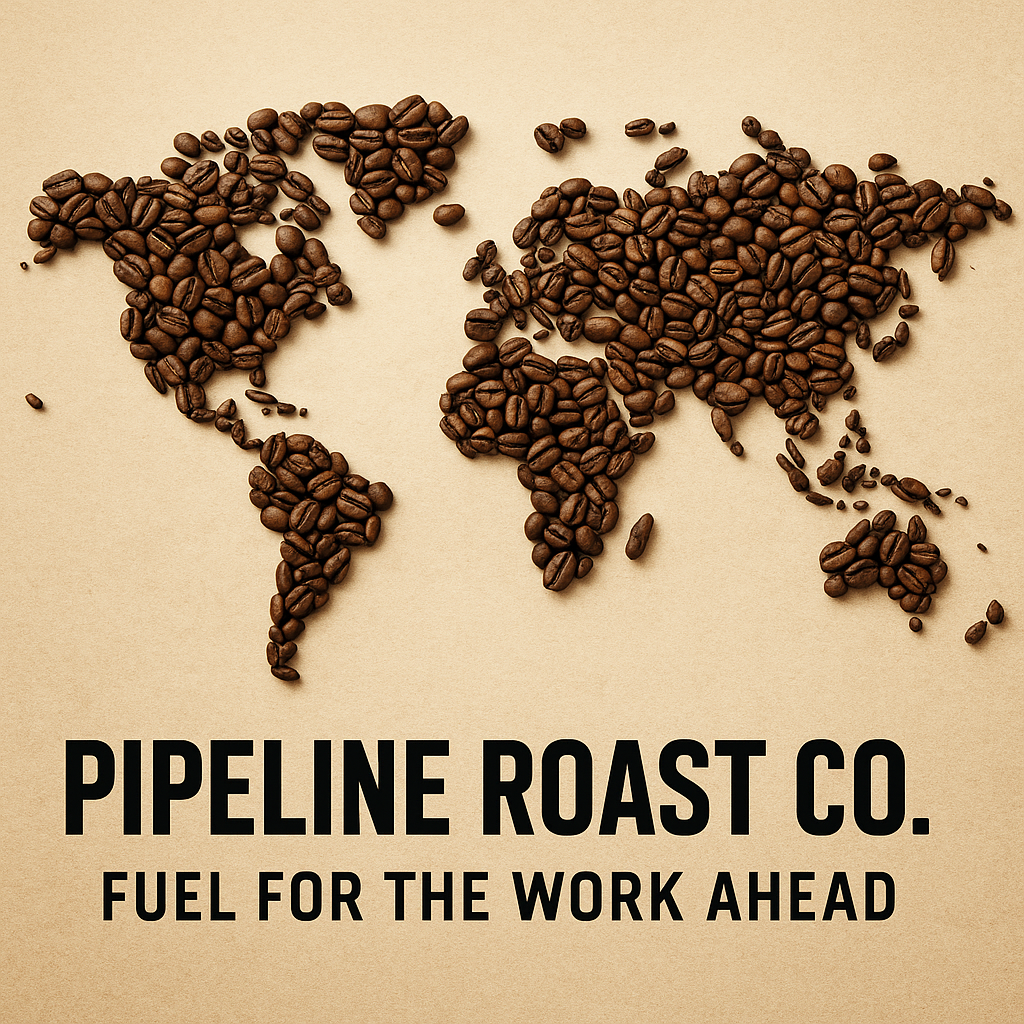
The World in Your Cup: How Coffee Origins Shape the Taste You Love
Share
Every Cup Has a Story
Coffee isn’t just a drink — it’s a journey.
Each bean carries the essence of its homeland: the soil, the altitude, the rain, and the hands that cultivated it. From the misty highlands of Ethiopia to the volcanic slopes of Central America, where your coffee comes from shapes how it tastes.
At Pipeline Roast Co., we believe every origin tells a story worth brewing. Understanding those origins helps you find the flavor that fuels your workday — whether you’re on a job site, behind a desk, or out chasing the next project.
What “Origin” Really Means
In coffee terms, origin refers to the specific country or region where coffee is grown. The growing environment — known as the terroir — includes everything from:
-
Altitude (higher altitude = slower growth = more complex flavors)
-
Soil composition (volcanic, loamy, clay, etc.)
-
Rainfall and temperature
-
Processing methods (washed, natural, honey process)
These factors dramatically affect the bean’s chemistry, influencing acidity, sweetness, aroma, and body.
That’s why coffee from Ethiopia tastes bright and fruity, while coffee from Sumatra feels bold, earthy, and deep.
You’re not just tasting caffeine — you’re tasting geography.
Latin America – Balanced, Bright, and Reliable
Regions: Colombia, Guatemala, Costa Rica, Brazil, Honduras, Peru
Latin America is the backbone of the coffee world. If you’ve ever described coffee as “smooth,” “balanced,” or “classic,” chances are it came from here.
Flavor Profile
Latin American coffees are known for:
-
Medium body
-
Bright, clean acidity
-
Notes of caramel, nuts, cocoa, and mild fruit
The high mountain elevations in Colombia and Guatemala create ideal growing conditions — cooler temperatures slow the bean’s development, producing complexity and sweetness.
Colombian coffee is world-famous for its mild, approachable profile.
Guatemalan coffee often leans richer, with hints of chocolate and spice.
Costa Rican beans deliver crisp citrus and honey-like sweetness.
If you love a cup that’s balanced and consistent, this region is your go-to.
Pipeline Pick:
☕ Cowboy Blend — A tribute to Central American harmony with industrial-strength flavor that holds up to any shift.
Africa – Bright, Floral, and Wildly Complex
Regions: Ethiopia, Kenya, Rwanda, Tanzania
Africa is coffee’s birthplace — and still its most diverse flavor region.
If Latin America offers comfort, Africa delivers adventure.
Flavor Profile
African coffees often feature:
-
High acidity and clarity
-
Fruity and floral notes
-
Lively, complex finishes
Ethiopian coffee (especially from Yirgacheffe and Sidamo) bursts with jasmine, blueberry, and citrus. It’s like drinking a fruit-forward wine — elegant and vibrant.
Kenyan coffee is bold, juicy, and bright, with blackcurrant or grapefruit notes and a crisp finish.
These coffees stand out in pour-overs or drip brews, where their natural brightness can shine.
Pipeline Pick:
☕ African Kahawa — A single-origin roast that’s as vibrant and alive as the continent it hails from.
Asia – Earthy, Bold, and Full-Bodied
Regions: Indonesia (Sumatra, Java, Sulawesi), Vietnam, India
If you like your coffee dark, heavy, and full of attitude — welcome to Asia.
These beans pack the kind of punch that keeps shift workers and go-getters powered through long nights.
Flavor Profile
Asian coffees typically have:
-
Low acidity
-
Heavy body
-
Earthy, herbal, and spicy notes
Sumatra coffee is known for its deep, earthy tones — often compared to cedar, cocoa, or even pipe tobacco. The traditional wet-hulled processing method unique to Indonesia enhances those bold, rustic flavors.
Java coffee offers a smoother, slightly sweeter body, while Indian Monsooned Malabar beans are aged in humid monsoon winds for a rich, mellow cup.
These coffees shine as espresso or dark roasts — the kind that taste best from a thermos on the worksite.
Pipeline Pick:
☕ Sumatra — Heavy, smoky, and full-bodied. Coffee that works as hard as you do.
The Pacific & Beyond – Smooth, Sweet, and Balanced
Regions: Papua New Guinea, Hawaii, Pacific Islands
The Pacific region combines the best of both worlds — smooth sweetness with a touch of tropical flair.
Flavor Profile
Pacific coffees often offer:
-
Medium acidity
-
Creamy body
-
Sweet, nutty undertones
Papua New Guinea beans have a clean cup with subtle fruit and floral tones, while Hawaiian Kona coffee is rich, buttery, and incredibly smooth.
These are great “bridge” coffees — not too bold, not too bright, just easy-drinking perfection.
Pipeline Pick:
☕ Papua New Guinea — Balanced and approachable, perfect for any time of day.
How Processing Impacts Flavor
Beyond geography, how the coffee is processed (after it’s picked) has a major effect on flavor:
| Processing Method | Description | Typical Flavor |
|---|---|---|
| Washed (Wet) | Beans are washed and fermented before drying | Clean, bright, acidic |
| Natural (Dry) | Whole cherries are dried in the sun | Fruity, sweet, heavy-bodied |
| Honey Process | Mucilage left on bean during drying | Sweet, balanced, syrupy |
| Wet-Hulled (Giling Basah) | Unique to Indonesia | Earthy, rustic, deep |
A natural-processed Ethiopian coffee might taste like berries and jam, while a washed Guatemalan has crisp acidity and chocolate undertones. It’s all about what the farmer chooses to highlight.
Altitude: The Hidden Flavor Factor
Altitude is one of the biggest unsung heroes in coffee flavor.
-
High-altitude coffee (4,000–7,000 ft) develops more slowly, producing harder beans with denser sugars. This equals brighter, sweeter, more complex coffee (think Ethiopia or Colombia).
-
Low-altitude coffee (below 3,000 ft) matures faster, creating milder, more earthy flavors (think Brazil or Sumatra).
That’s why you might notice a crisp, wine-like acidity in a high-grown bean and a smoky, mellow depth in a lowland roast.
Ethical and Sustainable Sourcing
At Pipeline Roast Co., we don’t just care about taste — we care about integrity. Because quality matters.
All of our coffees are specialty-grade, which means they’ve been carefully sourced, roasted properly, cupped for taste approval and inspected for quality. You can be proud knowing your coffee is top-tier and sourced properly.
Good coffee should make the world a little better — one cup at a time.
Pairing Origins with Your Taste
| Your Preference | Recommended Origin | Flavor Notes |
|---|---|---|
| Smooth, balanced, all-day brew | Latin America | Caramel, cocoa, nutty |
| Bright and fruity | Africa | Citrus, berry, floral |
| Deep and bold | Asia | Earthy, chocolate, spice |
| Smooth and sweet | Pacific | Honey, nut, mild fruit |
No matter what kind of coffee drinker you are — cream and sugar, black as midnight, or iced on the go — there’s an origin that matches your taste (and your grind).
The Pipeline Approach
We roast every batch small and fresh to order.
That means your beans don’t sit on a warehouse shelf for months losing flavor — they’re roasted, packed, and shipped with purpose.
Each Pipeline Roast Co. blend is designed to deliver industrial strength flavor and fuel for the work ahead — from early mornings to late-night shifts.
Because coffee shouldn’t just wake you up — it should move you forward.
Fuel for the Work Ahead
Your coffee has a story — now it’s time to taste it.
Explore the origins, try new blends, and discover which flavor speaks your language of hard work, grit, and good taste.
👉 Shop Freshly Roasted Coffee at PipelineRoastCo.com
Small Batch. Big Flavor. Industrial Strength.
